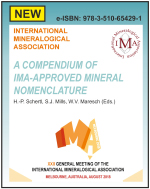Home page > Mineral of the Year 2014
Mineral of the Year 2014
More than 100 novel mineral species are discovered every year. Many of them represent chemical variations of previously known structure types and some are natural analogues of artificial chemical compounds. However, there is a large quantity of new minerals that possess unique chemical compositions, interesting and complex structures, beautiful crystals, or form under unusual conditions. To celebrate such species, the IMA council has developed an annual award – Mineral of the Year – in order to recognize the most interesting mineral published in the previous year. The members on the IMA Commission on New Minerals, Nomenclature and Classification have voted in this process. 2015 will be the first year that this award is given.
The Mineral of the Year for 2014 is ophirite! Ophirite, Ca2Mg4[Zn2Mn23+(H2O)2(Fe3+W9O34)2]·46H2O, is a new mineral species from the Ophir Hill Consolidated mine, Ophir district, Oquirrh Mountains, Tooele County, Utah, USA, and was described by Anthony R. Kampf of the Natural History Museum of Los Angeles County and co-authors: John M. Hughes (University of Vermont), Barbara P. Nash (University of Utah), Stephen E. Wright (Miami University), George R. Rossman (Caltech), and Joe Marty (Utah) (Kampf et al., 2014). Ophirite forms beautiful, orange-brown tablet-shaped crystals up to 1 mm in length and is the first known mineral to contain a lacunary defect derivative of the Keggin anion, i.e. a heteropolyanion missing some of its octahedral segments (Keggin, 1934). Phases with the Keggin anion are important in solid state chemistry as a catalyst (e.g. Sun et al., 2009).
We would like to mention that there were other very interesting phases which were close runner-ups, including bluebellite, Cu6[I5+O3(OH)3](OH)7Cl (Mills et al. 2014), qingsongite, BN (Dobrzhinetskaya et al. 2014) and peterandresenite, Mn4Nb6O19·14H2O (Friis et al. 2014).
Once again, we would like to congratulate the authors on the discovery of ophirite and encourage all of the readers to read about this fantastic find in the American Mineralogist article.
Sergey Krivovichev
IMA President
References
Dobrzhinetskaya LF, Wirth R, Yang J, Green HW, Hutcheon ID, Weber PK, Grew ES (2014) Qingsongite, natural cubic boron nitride: The first boron mineral from the Earth’s mantle. American Mineralogist 99: 764-772
Friis H, Larsen AO, Kampf AR, Evans RJ, Selbekk RS, Sánchez A, Kihle J (2014) Peterandresenite, Mn4Nb6O19·14H2O, a new mineral containing the Lindqvist ion from a syenite pegmatite of the Larvik Plutonic Complex, southern Norway. European Journal of Mineralogy 26: 567-576
Kampf AR, Hughes JM, Nash BP, Wright SE, Rossman GR, Marty J (2014) Ophirite, Ca2Mg4[Zn2Mn23+(H2O)2(Fe3+WO34)2]·46H2O, a new mineral with a heteropolytungstate tri-lacunary Keggin anion. American Mineralogist 99: 1045-1051
Keggin JF (1934) The structure and formula of 12-phosphotungstic acid. Proceedings of the Royal Society A 144: 75-100
Mills SJ, Kampf AR, Christy AG, Housley RM, Rossman GR, Reynolds RE, Marty J (2014) Bluebellite and mojaveite, two new minerals from the central Mojave Desert, California, USA. Mineralogical Magazine 78: 1325-1340
Sun CY, Liu SX, Liang DD, Shao K9Z, Ren YH, Su ZM (2009) Highly stable crystalline catalysts based on a microporous metal−organic framework and polyoxometalates. Journal of the American Chemical Society 131: 1883-1888



